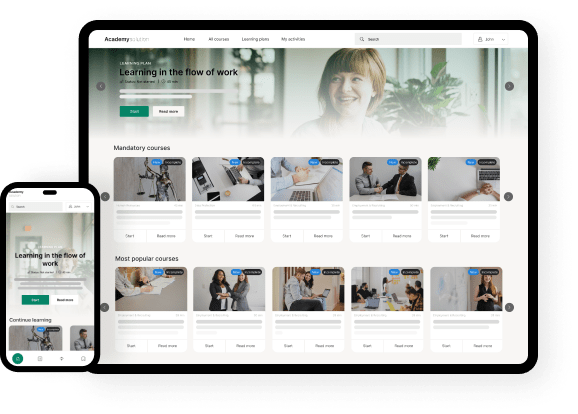Like many other company initiatives, employee onboarding can be a make-or-break process. That’s why it’s important to think ahead and start planning for a successful onboarding program the moment you begin your search for a new staff member. And if you’re looking for inspiration, look no further! In this blog post we’re sharing our five most useful tips to help you create an effective onboarding program.
Tip 1: Prepare a pre-onboarding checklist
An onboarding checklist can help you streamline the process. It will serve as a template defining all the methods, compliance documents, and stages that the new employee must accomplish in order to complete the onboarding program.
The components of your checklist can include the following:
- Important onboarding documents like employment tax forms, contract, payroll records, and an employee handbook.
- A new hire welcome email to inform other employees about the onboarding.
- Meeting schedules with the company heads or managers.
- Budget for food, key resource persons, and other onboarding materials.
- An onboarding lifecycle template to describe the employees’ recruitment journey — from pre-onboarding to their first day of work.
The more detailed your onboarding checklist is, the better prepared you and your new employee will be.
If you’re planning to create a more standardized onboarding system, referring to your list and its key components will secure you have a good head start.
Tip 2: Know the four C’s of onboarding
When you hire a new employee, you’ve most likely read their resume, had one or even multiple interviews, and gathered recommendations. You already know what you can expect from them. But what about the employee? Your new recruit is most definitely also curious as to what they can expect from you and your company. And that’s when your standard onboarding plan comes into play.
As a rule of thumb, your onboarding program should cover company policies, goals, values, and opportunities.
In her report, Talya N. Bauer of Portland State University neatly encapsulates these areas into four building blocks. The building blocks are often called the Four C’s and encompass compliance, culture, clarification, and connection. And in order to have success with your onboarding program it’s important to take note of these four building blocks.
Compliance
The lowest level of your onboarding program is where new employees learn about basic company rules and policies. During this part of your onboarding program, employees fill out all necessary onboarding documents. And you must make sure to provide enough details when explaining the relevance and significance of what your new staff member will go through.
Culture
Sometimes, there’s confusion regarding the true meaning of company culture. In general, culture is your company’s personality. It also covers your company’s ethics, norms, and values. Learning these essential elements during onboarding gives your employees a grasp on how things are run inside your company. It serves as their “moral compass” as they start their new journey within your organization.
Clarification
The onboarding process is the perfect time to explain or clarify your employees’ roles and responsibilities. Clarification ensures that they understand the scope and nature of their work and the extent to which they can increase their engagement. The worst thing you can do during an onboarding process is to provide insufficient data about their job description and assignments.
Connection
One of the goals of an onboarding program is to bridge the gap between new employees and their coworkers. Establishing such a connection can be a defining moment during the onboarding process. Why? Because employee onboarding is where healthy relationships begin and where good friendships take start. The onboarding stage is where you allow your new talents to build up trust with the company and its members. Ignoring this valuable component can leave your employees feeling uncomfortable, isolated, and unwelcome at the onset of their new professional journey.
Which of the Four C’s you choose to focus on depends on your company. Nonetheless, according to Bauer, the degree to which organizations leverage these four building blocks will determine their overall onboarding strategy.
Take for example Zappos, an online shoe and clothing retail business. While they believe that the technical aspects of their onboarding matter, “the culture piece is even more important”.
Tip 3: Emphasize collaborative onboarding
Once you have identified which of the Four C’s you want to prioritize, start breaking down tasks and designate them to different staff members. While it’s the sole responsibility of the HR Department to lead the onboarding process, it would be a spectacle if others chip in and show their support.
This is what we call collaborative onboarding. The beauty of this onboarding strategy is that cross-departmental engagement helps break down silos, harbor team connections, and foster mentorship.
Another innovative way to enhance collaborative onboarding is to use digital tools like a Learning Management System – often simply mentioned as an LMS. With its advanced mechanisms, using an LMS in your onboarding will help you improve communication processes, thus, increasing engagement.
Tip 4: Personalize employee onboarding experience
Personalization is a buzzword in the digital age and especially in the learning and development (L&D) industry. Nowadays, L&D professionals are highly focused on personalizing and customizing employees’ onboarding experience.
The rationale behind personalization is simple: onboarding is all about the experiences. Onboarding administrators must remember that they are dealing with people who all have unique needs and skills. Therefore, the onboarding process must be tailored based on different learning styles, job roles, and circumstances.
At Cursum, we always recommend these simple ways to personalize the onboarding experience:
- Use a wide range of educational media like videos, images, and interactive assessments.
- Specify information relevant to the new employee’s job role.
- Diversify your onboarding activities by throwing in fun games and engaging group activities.
- Take advantage of a blended learning approach.
- Consider the different learning styles of your employees when creating course content and materials.
- Build an online employee portal so that your new staff members can personalize their profiles.
Onboarding Trivia
According to Sapling, the average new hire onboarding experience consists of 54 activities. New employees will be assigned three documents to sign, upload, or acknowledge and 41 administrative tasks to complete. They are also expected to achieve 10 learning goals about company culture, market knowledge, and role alignment. These activities should ensure that the new hire is fully onboarded and integrated into his or her new role.
Tip 5: Invest in an onboarding platform
If you’ve followed our tips above, this last tip will serve as icing on the cake. You can of course choose to onboard your new employee the old-fashioned way without using any technology. However, we’re not going to sugar-coat it: investing in a Learning Management System will without a doubt ease your onboarding process.
As Emma O’Neill, Senior Content Marketer of LearnUpon, said:
The best onboarding programs aren’t just constructed by subject matter experts. They’re built by teams who truly understand how to mix content and tools, in this case, a learning management system (LMS), to make a process that’s efficient and achievable.
Emma O’Neill, Senior Content Marketer of LearnUpon
With an LMS, companies can administer consistent training programs even on a large scale. In the dawn of digital transformation, leveraging an advanced tool such as an LMS may be the biggest upside for startups. Here are the two main reasons why:
Employing an LMS reduces onboarding time
One of the benefits of using an LMS in onboarding is that it helps reduce time spent in disseminating information. By digitizing onboarding content, you can make sessions shorter and utilize the extra time for other activities. Some of the things you can do with an LMS include:
- A welcoming video and company overview
- Digital employee handbook
- Guide to set up company software or tools
- Digital instructions for compliance
It allows you to do remote onboarding
According to Workable Survey, 37.4 % of recruiters say that their biggest concern during the COVID-19 pandemic is the challenges of remote onboarding and training. At the same time, managers expect that onboarding, candidate engagement, and appraisal will remain challenging even after the pandemic has subsided.

Source: Workable Survey
Many employees have adjusted their working habits according to the pandemic, and in the coming years we’ll most likely see an increase in remote onboarding. Considering this as an early wake-up call, investing in an LMS for your onboarding program could be your best decision this decade.
Using an LMS for remote onboarding allows access to training content anytime and anywhere. An LMS with mobile application technology provides greater freedom for remote learners to accomplish their tasks at their own pace. Using a single platform with a plethora of functionalities eliminates onboarding angsts and offers greater flexibility – especially in situations such as this pandemic.
Build Your onboarding program using Cursum’s platform
You’ve now unlocked the secrets to a successful onboarding program, and it’s time to build your own onboarding strategy using a solid digital solution like ours.
At Cursum, we believe that bright ideas should be paired with the right technology. That’s how we help companies take their employee onboarding to the next level! Give us a call –it’ll be our pleasure to assist you with all your onboarding needs!


